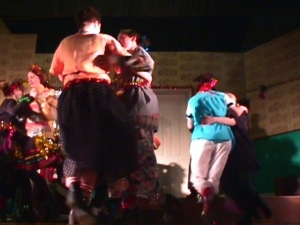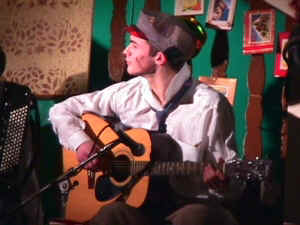|
Section 1 | top of page | previous section | next section | THE NEW INN MUMMERS FESTIVAL
|
| two |
three |
| four
Section 2 | top of page | previous section | next section | INTERNET PHOTOGRAPHS As photographs normally take much longer than text to travel across the Internet, you may have to wait for a while before you can see them on your screen. Those who are new to the Internet might like to know that there is usually a small display of some kind on Internet screens to indicate progress, and when the transfer is complete the word "done" or something similar appears. (Sometimes the indicator is a blue band at the bottom left-hand corner of the screen.) In case there are lengthy delays, we have included some outline information about the general history of mummers which you might like to read while you are waiting. Later, we hope to be able to add some information regarding the origins and history of the annual New Inn Mummers Festival (which began over twenty years ago). Sadly, some of the people responsible for starting the New Inn Mummers Festival have since passed away. In appreciation of their efforts, and of their success, we would like to dedicate this small contribution of ours to their memory. | top of page | previous section | next section |
|
| five |
| six |
| seven
Section 3 | top of page | previous section | next section | THE THINKING BEHIND THE MUMMERS IDEA It looks as though the ancient custom of mummery would have first come into being a very long time before people learned to read and write. Once human beings got to the stage where they began to feel there should be something more to life than just repeating daily chores, the idea of whole communities abandoning normal behaviour for a few days once in a while seems to have entered into somebody's mind. Dressing up in disguise, as the mummers often do to this day, would probably have became a key feature very quickly: because that way nobody rightly knew who was doing what. To increase the sense of fun, it seems plenty of colour (and sparkle) was added to the disguise - and lots of extra food and drink laid on. Once all of these things were in place, it is not too difficult to see that the possibilities for interesting developments during the festivities would have been almost endless. DNA testing suggests there has not been any really significant increase in the brain capacity of human beings for the past 10,000 years or so, and (all things considered) it looks as though the practice of mummery may have been around for all of that period, or possibly a little longer. | top of page | previous section | next section | |
| eight |
| nine |
| ten
Section 4
Section 4 | top of page | previous section | next section | MUMMERS IN THE VERY EARLY STAGES In a variety of forms most (if not all) of the early cultures and races seem to have adapted and developed the custom of mummery. As to which culture was first with the idea, nobody seems to know. However, the ancient Celts, if not themselves the originators, would almost certainly have been involved at a very early stage. Their remarkable love of dressing up and celebrating has been commented on many times in the writings of pre Christian Greek and Roman writers. As a further indication of possible early Celtic involvement, there are some archaeologists who suspect that the search for gold may have been the main reason for the ancient Celts coming to the Island of Ireland in the first place: because they had used up all that was easily available to them on mainland Europe. Their reason for wanting more gold seems to be that they needed it for the fabulous jewellery they liked to be seen wearing at their public celebrations. There is strong evidence also that the ancient Celts in Ireland regularly held a very important winter solstice celebration at Newgrange (Co. Meath) as far back as 3100 BC. On modern calendars the date of the winter solstice is December 21st (in the northern hemisphere); but, this date is a little different in some earlier calendars. (For further information on Newgrange, please look later on under TUROE STONE and SUPERDUMP headings in "Test Page Listing" at this web site.) | top of page | previous section | next section | |
| eleven |
| twelve |
| thirteen
Section 5 | top of page | previous section | next section | SATURNALIA Amongst the earliest written references to mummers are those connected with the Winter Solstice Roman Festival of SATURNALIA: which appears to have been well established as long ago as 400 BC, and which by all accounts was a period of wild revelry and unrestrained merry-making. To begin with at least, it seems to have been started by (and was for) farm labourers. In Roman mythology (largely based on a mixture of earlier Celtic, Egyptian, and Greek myths), the God SATURN was greatly revered: because his reign was thought of as a golden age. He was the God associated with agriculture and vegetation. Rome dedicated a day of the week (Saturní diés) to him. Eventually, "Saturní diés"(day of Saturn) became our "Saturday". During the Saturnalia Festival, it seems that a very large part of the fun involved turning as many aspects as possible of everyday social life upside-down, inside-out, and backwards. Slaves and masters swapped cloths for instance, and age and rank were all put to one side. Those of high social status dressed up in fantastic costumes. There was lots of music, singing, dancing, drinking, and all sorts of other things. People called on their friends, they exchanged gifts, and they wished each other a Happy New Year. The Romans at that time also had a particular God (unique to their culture) called JANUS, who often appeared on Roman coins as a figure facing in two directions. The month of January was called after him: because the winter solstice was a popular time of the year for many people to relax and to look back at the old year, and at the same time look forward to the new. (In contrast, the period around the Summer Solstice on June 21st would probably have been a very busy time for most of the many people connected with the land.) Eventually, Rome embraced the idea of the winter solstice marking the point in time where the "old year" ended and the "new year" started; and from 153 BC onwards the official Roman New Year began in Jánuárius (i.e. the month of Janus, or January as we now call it). A few hundred years or so after officially making January the start of the New Year, Rome replaced the Saturnalia Festival with the Festival of Christmas. To this day, mistletoe is very strongly associated with Christmas: and to the Celtic Druids of ancient times there was nothing more sacred than mistletoe (provided it grew on an oak tree). | top of page | previous section | next section | |



